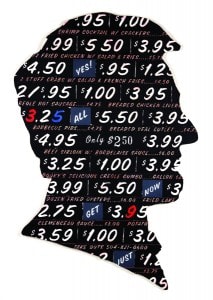
“Think Lincoln.” That was the missive that Eugenie Tsai, contemporary-art curator at the Brooklyn Museum, sent out to her colleagues when the museum acquired a recent sculpture by Skylar Fein. The piece, Black Lincoln for Dooky Chase (2010), shows a silhouette of the 16th president superimposed on a menu board offering fried oysters, creole gumbo, and other treats. The board looks like the ones in Dooky Chase, a beloved New Orleans eatery, in olden times, before the restaurant was destroyed by Hurricane Katrina. (It was later rebuilt.) Fein, a New York native who has lived in New Orleans since 2005, says he was inspired by a trip a teenage Lincoln took to the city, the site of notorious slave markets, an experience that may have influenced his decision to issue the Emancipation Proclamation.
Fein’s image is hardly the first picture of Lincoln in the museum’s collection, Tsai soon discovered, as staff members from different departments brought forth photos, printed matter, and a marble profile of the president, mounted on velvet-covered wood. They also found various examples of the silhouette, the 19th-century staple that lent Fein his form. “The decorative-arts curator took me into this storage area I’d never been to before, behind the period rooms,” Tsai says. “He showed me a painted glass silhouette by a well-known French silhouette cutter. I don’t know the last time it’s been shown, if ever.”
That silhouette is now part of an installation around the new acquisition on the fifth floor (through August), along with other historical items and contemporary works. One is Kara Walker’s 2005 print series “Signal Station [from Harper’s Pictorial History of the Civil War],” in which silhouettes overlay and subvert the historical narrative. The other is Moyra Davey’s artist’s book Copperheads, a collection of close-up photographs of banged-up pennies. The photos made Tsai think about how much the “profile of Lincoln permeates our everyday life,” she notes. “It’s a daily reminder of his major contribution to American history and culture.”
Written by Robin Cembalest